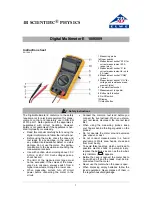Reviews:
No comments
Related manuals for EX310

INIA011
Brand: Velleman Pages: 28

Hotwire 8786
Brand: Paradyne Pages: 19

Unitest Hexagon 310
Brand: BEHA Pages: 80

EN300
Brand: Extech Instruments Pages: 9

411
Brand: Extech Instruments Pages: 18

2200
Brand: BGS technic Pages: 14

DMM3-Set
Brand: Gigahertz Solutions Pages: 2

97II
Brand: APPA Pages: 29

U1241B
Brand: Keysight Pages: 83

E 1006809
Brand: 3B SCIENTIFIC PHYSICS Pages: 4

1020
Brand: PeakTech Pages: 32

4090
Brand: PeakTech Pages: 40

35632 Series
Brand: Oakton Pages: 35

MS8301D
Brand: Mastech Pages: 10

EVM892
Brand: Velleman Pages: 80

DVM94
Brand: Velleman Pages: 93

DVM9915
Brand: Velleman Pages: 106

DVM903
Brand: Velleman Pages: 112

















